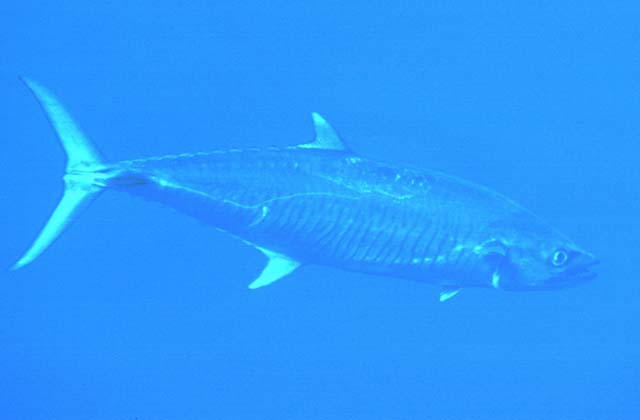| Scombridae (Mackerels, tunas, bonitos), subfamily: Scombrinae |
| 240 cm FL (male/unsexed); max.weight: 70 kg |
|
pelagic-neritic; depth range 10 - 70 m, oceanodromous |
| Indo-West Pacific: Red Sea and South Africa to Southeast Asia, north to China and Japan and south to southeast Australia, and to Fiji (Ref. 6390). Immigrant to the eastern Mediterranean Sea by way of the Suez Canal. Southeast Atlantic: St. Helena. |
|
Dorsal spines (total): 15-18; Dorsal soft rays (total): 15-20; Anal spines: 0-0; Anal soft rays: 16-21; Vertebrae: 42-46. Interpelvic process small and bifid. Swim bladder absent. Lateral line abruptly bent downward below end of second dorsal fin. Intestine with 2 folds and 3 limbs. Vertical bars on trunk sometimes break up into spots ventrally which number 40-50 in adults, and less than 20 in juveniles. Juveniles with large oval dark spots on body; middle third of first dorsal fin white, rest of fin black (Ref. 11228).
Description: Characterized further by bluish grey color dorsally, shading to silvery ventrally; white tipped second dorsal and anal fins; fully scaled body; elongate body, depth 4.8-5.6 in SL and compressed; large mouth, exposed maxilla on cheek and extending to below rear margin of eye; large teeth in jaws, compressed and triangular; presence of teeth in vomer and palatines (Ref. 90102). |
| Distributed from near edge of continental shelf to shallow coastal waters, often of low salinity and high turbidity (Ref. 30199, 48637). Also found in drop-offs, and shallow or gently sloping reef and lagoon waters (Ref. 1602, 48637). Usually hunts solitary and often swim in shallow water along coastal slopes (Ref. 48637). Known to undertake lengthy long-shore migrations, but permanent resident populations also seem to exist. Found in small schools (Ref. 9684). Feed primarily on small fishes like anchovies, clupeids, carangids, also squids and penaeoid shrimps. Eggs and larvae are pelagic (Ref. 6769). A lipid-soluble toxin, similar to ciguatoxin has been found in the flesh of specimens caught on the east coast of Queensland, Australia. Marketed fresh, dried-salted (Ref. 9684), frozen, smoked, and canned (Ref. 9987); commonly made into fish balls. |
|
Near Threatened
(Ref. 96402)
|
| reports of ciguatera poisoning |
|
Source and more info: www.fishbase.org. For personal, classroom, and other internal use only. Not for publication.
Page created by Jen, 05.08.02,
php script by kbanasihan 06/09/2010 ,
last modified by
dsantos, 20/08/10

